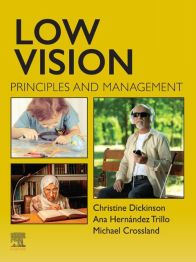Providing an ideal balance of theory and practice, Low Vision: Principles and Management covers all aspects of providing effective eye care to individuals with visual impairment. This concise yet comprehensive resource covers everything from theoretical background to current rehabilitative aids and low vision treatment strategies—all while adopting a practical approach to vision care. It brings practising eye care professionals and students fully up to date with current optical and electronic devices and how they are used in everyday practice, as well as evidence-based vision rehabilitation guidelines.
Key Features
-
Features comprehensive guidance on visual rehabilitation for acuity loss and visual field loss.
-
Describes a wealth of practical advice and real-world case scenarios to help guide your day-to-day patient interactions as well as your most challenging situations.
-
Covers hot topics, including the link between mental health and low vision, assistive technologies, measures of quality of life and other outcome measures, WHO classifications of visual impairment, and best practices for auditing and commissioning vision services.
-
Contains over 200 diagrams, illustrations, and patient photos to aid in visual understanding.
-
Explains how eye care professionals can work within a multi-disciplinary team to provide complete care.
-
An eBook version is included with purchase. The eBook allows you to access all of the text, figures and references, with the ability to search, customize your content, make notes and highlights, and have content read aloud.
Author Information
By Christine Dickinson, BSc PhD FCOptom PGCertHE, Professor of Clinical Optometry and Lead for Undergraduate Masters, Division of Pharmacy and Optometry, Faculty of Biology Medicine and Health, University of Manchester, Manchester, UK; Ana Hernandez Trillo, BSc MSc PhD PGDipMEd SFHEA, Senior Lecturer in Optometry, Division of Pharmacy and Optometry, Faculty of Biology, Medicine and Health, University of Manchester, Manchester, UK and Michael Crossland, Senior Research Fellow, UCL Institute of Ophthalmology, University College of London and Specialist Optometrist, Moorfields Eye Hospital NHS Foundation Trust, London, UK
PART 1 Defining Low Vision
1 What Is Low Vision?
2 Prevalence and Causes of Low Vision
3 Clinical Measures of Visual Performance
4 Patient Centred Outcome Measures
PART 2 Magnification as a Strategy for Improving Visual Performance
5 Magnification
6 Relative Size Magnification: Increasing the Object Size
7 Relative Distance Magnification: Decreasing the Viewing Distance
8 Transverse Magnification
9 Angular Magnification
PART 3 Other Methods for Visual Rehabilitation
10 Contrast and Glare
11 Illumination and Lighting
12 Aids for Peripheral Field Loss
13 Special Training Techniques for Visual Field Loss
14 Rehabilitation Techniques for Nystagmus
15 Sensory Substitution
16 Inclusive and Universal Design
PART 4 Clinical Procedures
17 The Low Vision Assessment
18 The Eye Examination
19 Prescribing Magnification
20 Instruction and Training in the Use of Magnifiers
21 Evaluating Low Vision Services
22 The Place of Low Vision in Optometric Practice
23 Case Studies
PART 5 Appendices
Appendix 1: Useful Information
Appendix 2: Sample Record Sheets
Appendix 3: Patient Literature
Appendix 4: Examples of Clinic Letters
Index
"This book discusses low vision, covering common causes, testing, and care for meeting patients' goals and satisfying pressing visual needs. The ebook presents the same format as the paper copy and includes hyperlinks to various sections and many of the references noted at the end of each chapter." ©Doody’s Review Service, 2023, Cynthia Heard, OD (Southern College of Optometry)


